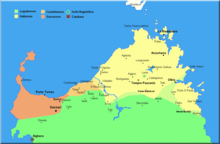Sassarese language
| Sassarese | |
|---|---|
| Sassaresu, Turritanu | |
| Pronunciation | [sasːaˈrezu] |
| Native to | Italy |
| Region | Sardinia |
|
Native speakers
|
100,000 (1993) |
| Latin (Italian alphabet) | |
| Official status | |
|
Recognised minority
language in |
Sardinia (Italy)
|
| Language codes | |
| ISO 639-3 | |
| Glottolog | sass1235 |
| Linguasphere | 51-AAA-pe |

Languages of northern Sardinia
|
|
Sassarese (Sassaresu or Turritanu) is an Italo-Dalmatian language and transitional between Corsican and Sardinian. It is regarded as a Corsican–Sardinian language because of Sassari's historic ties (and neighborhood) with Tuscany and Corsica. Despite the heavy Sardinian influences (especially in the vocabulary and phonetics), it still keeps its Tuscan roots, which closely relate it to Gallurese. The latter is regarded as a Corsican dialect despite the geographic location, although this attribution is a matter of controversy. It can be considered a transitional language between Italo-Dalmatian languages and Sardinian. It has several similarities to Italian and in particular the old dialects of Italian from Tuscany.
Sassarese is spoken by approximately 100,000 people, out of a total population of 175,000, in the northwest coastal areas of Sardinia, Italy. Large Sassarese-speaking communities are present in Sassari, Stintino, Sorso, and Porto Torres. Sassarese's transition varieties towards Gallurese, known as the Castellanesi dialects, can be heard in Castelsardo, Tergu, and Sedini.
Sassarese emerged as an urban language of commerce in the latter part of the age of the Giudicati (13th–14th century); it is based on a mixture of different languages, namely Corsican, Tuscan, and Ligurian; a strong Logudorese influence can be felt in its phonetics, syntax, and vocabulary; a minor influence in vocabulary was exercised by Catalan and Spanish. There exist many modern and older works both on and in Sassarese, and a number of cultural, social, and theatre events are held regularly in connection with it.
...
Wikipedia
